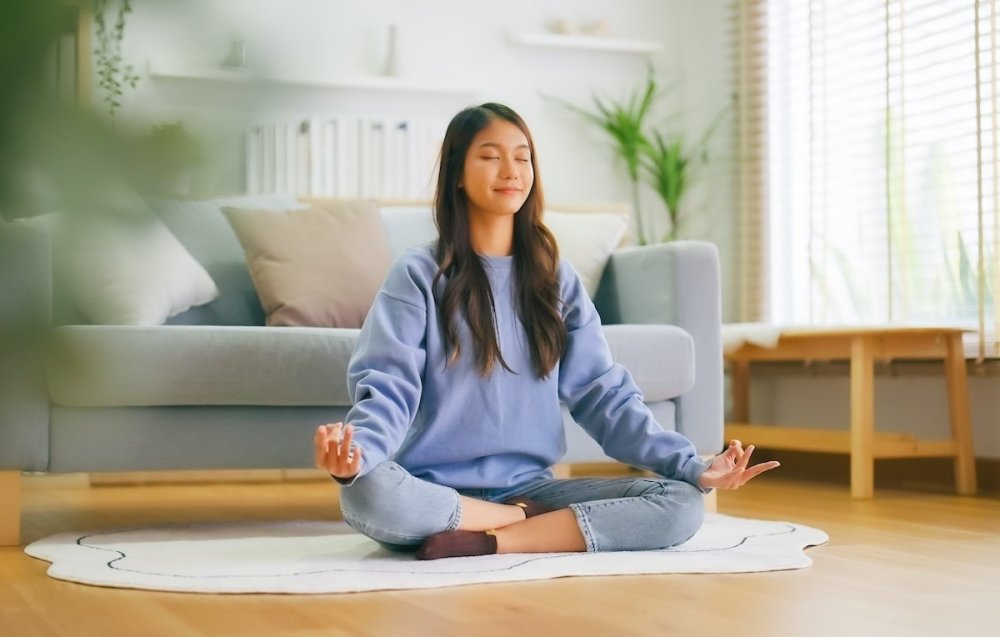Meditation is more popular than ever, but many common misconceptions about the practice still remain. So, from aiming to control your thoughts to only meditating cross-legged, Ann Vrlak debunks seven common meditation myths.
Meditation is one of the most natural, simple activities we can do, but, ironically, many people find it difficult. There are some good reasons why meditation practice can be challenging, especially for beginners, but one of the biggest reasons is the many misconceptions about meditation and what’s supposed to happen when you do it.
Whether you have tried meditation before or not, we’d like to debunk some of the most common meditation myths. We hope this might inspire you to try again – or give this healthy habit a chance.
Myth 1. Meditation Means I Have to Control My Thoughts
The belief that you have to control your thoughts is the biggest misconception about meditation. Thinking is what your mind does and, generally, it is very good at it! When you try to stop your thinking, your thinking will usually become more active. It’s like trying to stop a river from flowing.
Meditation is about learning to relate to your thinking differently. In particular, a core meditation skill is observing your thoughts. To stay with the river analogy, it’s like standing on the shore of the river watching thoughts go by, rather than being carried away by it.

Meditation is about observing thoughts, not controlling them
This objectivity helps you to better understand what you think about and how your mind behaves. You become familiar with thoughts that upset you or lead you toward bad decisions. Most importantly, it strengthens your “observing mind,” the part of your attention that can be a calm, caring witness of your experiences. This is a much more powerful skill than it may sound.
Myth 2: Meditation Makes People Check Out
What image comes to mind when you think of someone meditating? It might be someone sitting cross-legged on the floor, with their eyes closed. This image seems to suggest someone who is out of the flow of life, “not letting things affect them.”
“Believing you have to control your thoughts is the biggest misconception about meditation. Thinking is what your mind does and, generally, it is very good at it!”
Like some meditation misconceptions, there is a hint of truth in this, and a lot of misunderstanding. Often meditation is done in a quiet place, away from daily activity, so you can learn to focus your attention – where you can develop that objectivity we just mentioned.
This builds your self-awareness and balance to help you manage life’s challenges with less stress. You become more aware, more engaged – not less. Indeed, meditation deepens your connection with yourself which helps you feel more connected to – and concerned for – others.
Myth 3. Meditation Can Only be Done Sitting Cross-legged
The image we mentioned before of someone sitting cross-legged on a cushion is traditional, that’s true. This posture puts the body into an aligned, alert position that supports your nervous system. But, in fact, you can meditate lying down or in any position you like because meditation is for everyone.
MORE LIKE THIS:
- How to Meditate in Bed for Beginners
- Outdoor Meditation: How to Meditate in Nature
- Mindfulness Vs Meditation: What's the Difference?
Fitness, age, injury or energy level does not determine whether or not you can benefit from meditation. In fact, there is an ancient meditation practice called yoga nidra that's done lying down and is a deep relaxation experience for mind and body.
Myth 4. I Should Feel Peaceful or Relaxed When I Meditate
What if you feel anxious or agitated when you meditate? Does it mean “you’re not doing it right” or “you can’t meditate”? The myth that you will always feel peaceful or relaxed when you meditate is one of the most unfortunate misconceptions about meditation.

You can practise meditation anywhere: there are no rules
These feelings are, in fact, common first experiences with meditation – and sometimes a recurring one. Why? Because you are slowing down and paying attention to your mind and body in ways you do not usually do. Often there is some stress or an uncomfortable emotion under the surface that we are too busy to notice. Meditation isn’t causing the discomfort, it’s just showing you it’s there. From here, you learn skills to help you respond to your challenges with mindfulness and compassion.
Meditation is not about achieving any particular feeling. It’s about learning to be with your experience, as it is, with kindness and curiousity. If you feel anxious, the practice is to be kind with it – not to try to get rid of it. The goal is to grow your ability to be with your experiences, good and bad, without resisting and judging.
Myth 5. I Just Don’t Have Time to Meditate
There is a popular saying in meditation circles: “If you don’t have five minutes to meditate, you should meditate for 30.” In other words, if your days are so busy that taking five minutes to breathe and be present seems like too much, you need even more of a break!
This is a meditation misconception that is easy to accept because modern living does encourage us to do more and more, faster and faster. But, taking breaks to pause, rest our minds and refresh our energy make us more productive, not less.
“While there are good reasons to use traditional meditation postures, there are also many benefits to practising meditation lying down or any position you like.”
Not only that, but there are many ways to take short meditation breaks in your day. Use a daily activity as a reminder to do a three-minute conscious breathing exercise, like when you're getting ready for bed or getting dressed for work in the morning. Developing a habit of mini-meditations is a wonderful way to create restful spaces in your day. A little meditation can go a very long way.
Myth 6. I Need to Have a Spiritual or Religious Belief to Meditate
Some of the core meditation practices that are still with us today came out of ancient spiritual traditions. But, those traditions, like Buddhism, have a deep foundation in human psychology and also in equality.
MORE LIKE THIS:
- 10 Types of Meditation: Which Style is Best For You?
- Meditation For Beginners: Our Top 6 Videos
- Does Meditation Really Work? Here's What Science Says
Meditation was a practice created to help people understand the common causes of suffering and of happiness that affect everyone. There was not, and still is not, any need to believe in any spiritual dogma to meditate. All you need is a desire to better understand yourself to help you lead a happier life.
We also now have decades of scientific data that has proven the benefits of meditation, from stress relief to alleviating depression, are shared among secular and non-secular people.
Myth 7. Meditation Is Self-Centered
Does “going inward” in meditation encourage you to become self-centred? This is one of the more well-meaning misconceptions about meditation. A practice that made you more concerned about yourself than others would not add anything very positive to the world.

Meditation doesn't have to be done cross-legged in Lotus position
But, meditation is just the opposite. One of the effects of understanding ourselves better through meditation is understanding others better. When you see your own anxiety and work with it compassionately, something automatically happens: you have compassion for others who experience anxiety too. When you relieve your own anxiety through kind attention, you may want to do the same for someone else.
Takeaway: meditation myths
I hope I've dispelled some of the myths about meditation you may have heard. Especially in the modern world, meditation can seem like an unusual activity, something foreign to our usual way of doing things.
It’s true in some ways, but that’s actually a good thing. Taking some time to slow down and breathe, for example, is a simple, healthy antidote to being constantly active. Paying attention to and being kind to your experiences can help you be more at ease in yourself when daily pressures are piling up.
If you’d like to try meditation, keep these myths about meditation in mind. Meditation is always meant to be a safe space where you show up as you are, and are met without judgement or expectation. •
Images: shutterstock/Monster Ztudio, shutterstock/Max Belchenco, shutterstock/ABO PHOTOGRAPHY
happiness.com | The fine art of being: learn, practise, share
Are you a happiness.com member yet? Sign up for free now to enjoy:
■ our happiness magazine with practical life tips
Gratitude | Stress Management | Mindfulness
Written by Ann Vrlak
 Ann Vrlak is Founder of OneSelf Meditation and a meditation practitioner for over 25 years. She’s a Certified Meditation Teacher for adults and for children (the best job ever!). She loves to share how the perspective and practice of meditation can support people with their everyday stresses and on their journey of self-discovery.
Ann Vrlak is Founder of OneSelf Meditation and a meditation practitioner for over 25 years. She’s a Certified Meditation Teacher for adults and for children (the best job ever!). She loves to share how the perspective and practice of meditation can support people with their everyday stresses and on their journey of self-discovery.




Join the conversation
You are posting as a guest. If you have an account, sign in now to post with your account.
There are no comments to display.